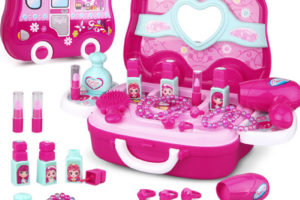image: iStock
A breastfeeding latch refers to how a baby engages their lips onto the breast’s nipple while breastfeeding. A good latch happens when the mother is comfortable and the baby is well-aligned to the mother’s body.
The correct breastfeeding latch can help prevent breastfeeding-related problems, such as sore and painful nipples. It also lets the baby feed adequate milk and grow well. Besides, a good latch ensures sufficient stimulation of the breasts for optimal milk production (1).
This post will tell you about the importance of a good latch, latch techniques, common issues with latching, and ways to rectify an incorrect latch.
What Is A Proper Breastfeeding Latch?
You may tell the baby has a good latch on the breast when the baby’s (2):
- Chest and stomach rest against your body, and the head is straight and not turned to either side.
- Chin touches your breast.
- Mouth is wide open and engaged around the areola (the dark area around the nipple) and not just the nipple.
- Lips are turned out like a fish.
- Tongue cups the areola.
- Ears move slightly.
- Eyes suggest alertness since the baby is engrossed in feeding.
The mother may also be able to sense the following attributes of a good latch (3).
- The latch is comfortable and pain-free.
- The American Academy of Pediatrics suggests that when the baby is latched properly, you should be able to draw an imaginary straight line connecting the baby’s ear, shoulder, and hips.
- The baby latches with their efforts, and you do not have to sit in awkward postures to make the baby latch to the breast.
- You do not hear slurping sounds. If you hear them, it indicates that the latch is poor and the baby is swallowing air.
Step-By-Step Guide To Establish A Good Latch
The following steps may help you and the baby learn how to latch sooner and in the correct way (4) (5).
- Get in a comfortable chair with good back support to avoid straining your back and neck. Put a foot-stool under your legs to get a proper posture.
- Use a good feeding pillow if you are comfortable using one. It will help get the baby in a proper position to latch and provide good support to the mother.
- Rubbing the nipple on the baby’s upper lip will stimulate the baby to open their mouth.
- Once the baby opens the mouth, he/she will try to latch onto the breast. Do not shove the breast. Let the baby take the lead.
- The baby’s mouth should be wide open, and the lips should be flanged out like that of a trumpet or a fish. If the baby hasn’t opened the mouth enough, you may try pulling the lips apart gently using your fingers.
- The baby’s lips should go around the areola and not only the nipple.
- The baby’s tummy should be in contact with your body at all times while feeding.
- Support the baby’s upper body with the arm on the side of the breast in use. Thus, if the baby is feeding on the right breast, use the right arm to support the baby’s upper body. Use the left arm to support the baby’s hips and legs.
- When nursing from the right breast, support the baby’s head in the inner fold of your right elbow. You may adjust the arm to find a suitable position for the baby.
- The baby’s ear, shoulder, and hips should be in a straight line. It will help the baby swallow the milk well.
- The baby’s nose should be right opposite the nipple, and their chin should touch the breast.
- Some babies may have their noses too close to the breast. If you are concerned about breathing, gently adjust your arms’ position to change the position of the baby’s head. You may also hold the breast in a “U” or “C” hold, gripping the areola between your fingers and thumb. Make sure not to push the breast into the baby’s mouth and only guide it away from the baby’s nose.
- You may sense once the baby is done breastfeeding since they seem less alert or fall asleep once full. Gently move the baby’s head away from the nipple, and the latch will break on its own. If the latch persists and you are certain the baby is done feeding, use your finger to break the suction between the mouth and the nipple gently.
Breastfeeding Latch Techniques
There are two schools of thought on latching techniques. You may either use the traditional latching technique or try the asymmetric latching technique.
- Traditional latching technique: It is the conventional latching technique. The nipple and areola are at the center of the baby’s mouth. The baby will take in as much areola as possible. You will see an equal amount of the areola’s circumference outside the upper and lower lips (5).
- Asymmetric latching technique: This technique suggests the nipple is pulled and pointed to the palate (roof of the mouth) in a way that the baby’s tongue cups the lower part of the nipple. It means more of the areola is covered by the lower lips than the upper lips (6).
It may be difficult to see the areola and the latch so closely in a tiny baby. Latching is a technique that both you and your baby will learn with time and practice. Each baby is different. Choose a technique that makes breastfeeding comfortable for you and your baby.
Signs Of A Poor Latch While Breastfeeding
You may notice the following signs if the baby is not latched to the breast correctly while breastfeeding (1) (4) (7).
- Rapid chin movement instead of the circular movement of the jaws
- Clicking or smacking noises
- Latch breaks repeatedly
- Chin does not touch your breast
- You do not sense the baby swallowing
- Persistently tender or sore nipples
- Cracked or bleeding nipples
- Flat, misshaped, or creased nipple after the baby unlatches
If you notice any of these signs, unlatch your baby and attach them again. If your baby consistently has trouble latching correctly, contact a lactation specialist.
Causes Of Latching Problems In Babies
The following situations and problems may make it difficult for the baby to latch correctly (8).
1. Incorrect position: If the baby is not positioned correctly and the nipple is out of reach, they could have trouble establishing a good latch. Adjust your position and the baby to ensure a deep latch. The baby’s ear, shoulder, and hips should always be in a straight line to achieve tummy-to-tummy contact and a deep latch.
2. Empty breast: The baby may get cranky and unlatch if the breast is empty. You may check for milk flow by gently expressing milk with your hand. You may also switch breasts.
3. Baby is uncomfortable: A baby who is sleepy or gassy could have trouble establishing a good latch. You may check for the possible cause. You may try skin-to-skin contact to soothe the baby. Choose a quiet, dim-lit place in your house and talk or sing to your baby to calm them down.
4. Severe breast engorgement: Breast engorgement could cause the breast and the nipple to become hard, making it difficult for the baby to latch. It is more common in the initial weeks after childbirth when the milk supply is not well established. Try hand-expressing or pumping excess milk before attempting to latch the baby.
5. Poor sucking reflex: The baby may not have a deep latch due to poor sucking reflex. There could be various reasons behind it. For instance, premature babies often have poor primitive reflexes due to an underdeveloped body. Check with your baby’s pediatrician if you suspect that the baby has a poor sucking reflex.
6. Flat or inverted nipples: Some women may have flat or inverted nipples, making it a bit difficult for the baby to latch. However, it is not impossible to feed the baby with flat or inverted nipples. You may use a nipple shield to help with breastfeeding. Speak to a lactation consultant to learn ways to establish a deep latch with flat or inverted nipples.
7. Cleft lip and palate: Cleft lip and palate are congenital defects, causing an opening in the lip or palate (roof of the mouth), respectively. These conditions usually make it difficult for a baby to latch to the breast, and they may require feeding from specialized bottles. Thankfully, these conditions can be corrected with surgery, which may eventually help the baby latch to the breast for feeding (9).
8. Tongue-tie: Tongue-tie is a birth defect where the tongue is tethered to the floor of the mouth. Thus, it makes it difficult for the baby to cup the tongue around the lower portion of the areola. The condition can be treated with surgery.
9. Genetic syndromes: Babies with certain genetic disorders and syndromes, such as Down syndrome, could have low muscle tone. It could cause them to have poor primitive reflexes, including sucking reflex. The muscle tone could also be poor to establish a deep latch. Nevertheless, you may be able to breastfeed with some practice and guidance from a lactation consultant.
Best Nursing Positions To Help A Baby Latch
The best nursing position is the one that makes you and your baby feel the most comfortable with breastfeeding. You may try the following breastfeeding positions and pick the one that suits you and your baby the most.
- Cradle hold
- Cross-cradle hold
- Football hold
- Football hold for twins
- Side-lying position
Breastfeeding is a rewarding journey for both the mother and the baby. Most women, especially first-time mothers, may usually face issues with breastfeeding. It takes time for you and your baby to determine the best way and position to establish a good latch. Therefore, be patient and do not hesitate to try techniques that you sense may be useful. If you or your baby experience persistent problems with latching, speak to a lactation consultant or a pediatrician.
References:


































